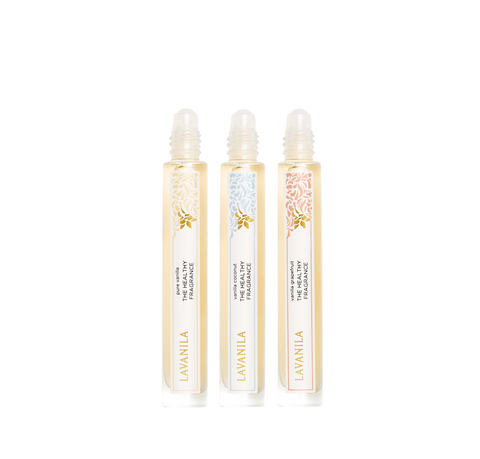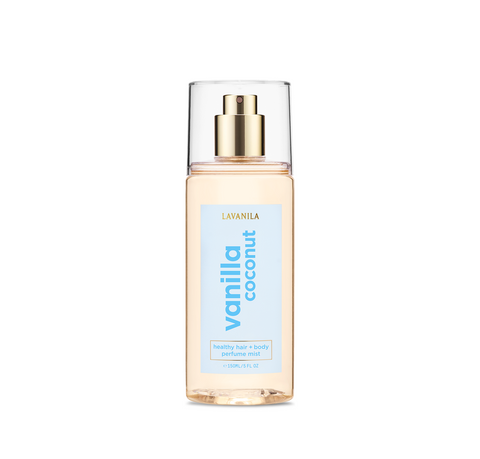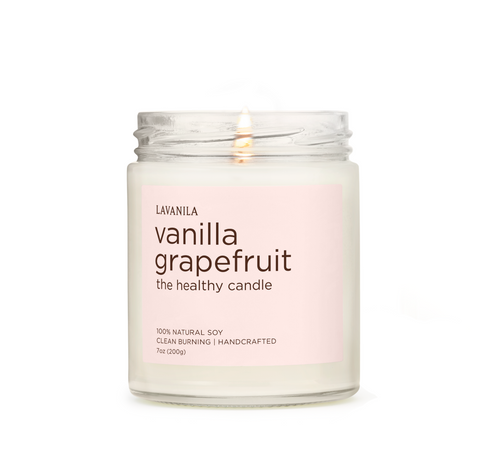The question “Does perfume cause cancer?” has become one of the most frequently searched skincare and beauty topics online — and it’s easy to see why. For years, fragrances were seen purely as a form of self-expression: a quick spritz of confidence, a touch of personality, a signature scent that told the world who you were. But as consumers have grown more aware of what goes into their beauty products, a deeper concern has taken center stage — what are we really putting on our skin each day?
Many people now question whether certain perfume ingredients could have potential long-term health effects, especially since so many formulas rely on synthetic chemicals and undisclosed fragrance blends. While not all synthetic ingredients are harmful, the lack of transparency and the complex mix of compounds used in conventional perfumes have led to growing curiosity — and caution.
At Lavanila, we believe fragrance should never come at the expense of wellness. Our approach to clean beauty centers around safe, naturally derived ingredients that deliver lasting scent without unnecessary risk. But before we explore what makes clean fragrance different, let’s unpack why so many are asking the question: does perfume cause cancer?
Why the Question “Does Perfume Cause Cancer?” Is So Common Today
Over the past decade, conversations about ingredient safety have transformed the beauty industry. Once, consumers rarely checked labels — now, they scrutinize every ingredient list, researching what each chemical means. This awareness grew from scientific studies, documentaries, and wellness movements that revealed how many everyday products include ingredients linked to irritation or potential hormone disruption.
As this transparency movement expanded, fragrance — one of the most secretive categories in personal care — came under scrutiny. Unlike skincare or food, perfume labels can simply list “fragrance” as a single ingredient, even if that blend contains hundreds of individual chemicals. This ambiguity made consumers wonder: if we don’t know what’s in it, could it harm us?
The question does perfume cause cancer isn’t driven by fear, but by a growing desire for honesty and health-conscious living. It reflects how people are choosing products that align with their values — safer, cleaner, and more transparent choices for everyday routines.
What the Rise of Clean Beauty Reveals About Consumer Concerns
The clean beauty movement has redefined what people expect from their personal care products. It’s no longer enough for a perfume to smell luxurious; it should also feel safe and nurturing. The rise of brands focusing on non-toxic, plant-based, and transparent formulas shows how deeply consumers care about what touches their skin.
In this environment, conventional perfumes face questions about their safety — not only because of potential health links, including concerns some studies raise about breast or skin cancer, but also because of the secrecy surrounding synthetic blends. Meanwhile, clean fragrance creators, like Lavanila, have stepped forward to provide an alternative: products that offer beautiful, long-lasting scents crafted from naturally derived ingredients and pure essential oils.
When consumers ask whether perfume causes cancer, what they’re really seeking is trust — confidence that their fragrance is as pure as it is pleasurable.
What’s Actually Inside Conventional Perfumes
Synthetic Fragrance Blends and Their Chemical Complexity
Modern synthetic perfumes are intricate chemical compositions designed to mimic natural aromas or create entirely new ones. A single fragrance formula may include anywhere from 50 to 300 ingredients — many of which are proprietary. These blends often contain phthalates, synthetic musks, and fixatives that help scents last longer on the skin but may also raise questions about long-term exposure.
Phthalates, for instance, have been studied for their potential to disrupt hormone function. While not every perfume contains them, the lack of transparency makes it difficult for consumers to know which do. Similarly, some synthetic musks can accumulate in the body over time, a quality that has caused concern among environmental and health researchers.
Why Some Ingredients Raise Cancer-Related Questions
When asking does perfume cause cancer, the concern often centers on specific chemicals historically used in fragrance manufacturing. Ingredients such as certain nitro musks and formaldehyde-releasing preservatives have been phased out or restricted in many countries, but traces can still appear in older formulations or imported products.
The worry isn’t necessarily about one spritz of perfume — it’s about accumulated exposure. Many synthetic compounds are designed to linger on the skin and in the air. Over time, continuous exposure, combined with other sources of chemical contact in daily life, has made people more cautious about what they apply.
The Lack of Transparency in Many Commercial Formulas
Perhaps the biggest issue fueling the question does perfume cause cancer is the lack of ingredient disclosure. The term “fragrance” can legally represent a cocktail of dozens or even hundreds of chemicals, many of which are not individually listed.
This means consumers can’t easily determine what they’re exposed to — even if they want to make informed choices. That uncertainty has sparked a shift toward clean perfume brands that value full transparency.
For example, at Lavanila, our formulas clearly identify their naturally derived ingredients, using safe, effective botanicals and pure essential oils to create scents that are luxurious yet trustworthy. Transparency isn’t just part of our process — it’s part of our philosophy.
Does Perfume Cause Breast Cancer? What Studies Show So Far
Scientific discussions about whether perfume could contribute to breast cancer risk often focus on endocrine disruptors — chemicals that may interfere with hormone regulation in the body. Certain synthetic fragrance components, like phthalates, have been studied for their potential to mimic or block natural hormones.
Although research remains ongoing, these findings have prompted caution. The breast tissue is highly sensitive to hormonal changes, so even small disruptions over time might play a role in long-term health outcomes. While direct links between perfume and breast cancer haven’t been conclusively proven, the possibility has made many consumers more selective about the products they use daily.
What Scientists Agree On — and What Needs More Research
Most experts agree on one thing: more transparency and long-term studies are needed. Many existing studies show potential associations between certain synthetic fragrance compounds and hormone-related changes, but not definitive causation. However, this uncertainty doesn’t mean the concern should be dismissed — it highlights the importance of choosing products with safer, tested ingredients.
Clean beauty brands, like Lavanila, are built around this philosophy of precaution. By using ingredients inspired by nature and avoiding harsh synthetics, our fragrances provide peace of mind for those who want the pleasure of scent without the worry of hidden risks.
Does Perfume on Skin Cause Cancer? Understanding Absorption and Impact
How Skin Absorbs Fragrance Molecules Over Time
The skin isn’t just a surface — it’s the body’s largest organ, and what you apply to it can be absorbed in small amounts. Traditional perfumes, applied directly to pulse points, can deliver synthetic fragrance compounds through the skin barrier and into the bloodstream.
While the absorbed amounts are typically low, prolonged and repeated use can increase overall exposure. For people with sensitive skin, some ingredients may cause irritation or inflammation, which further compromises the skin’s protective function. This cumulative interaction has prompted many to question — does perfume on skin cause cancer, especially when used daily for years?
Evaluating Long-Term Exposure in Everyday Use
When assessing whether perfume on skin could contribute to cancer risk, researchers look at patterns of chronic exposure — not one-time use. Synthetic ingredients that persist on the skin or in the body raise questions about bioaccumulation over time.
Even without definitive proof of cancer links, many experts encourage minimizing unnecessary chemical exposure whenever possible. That’s where clean fragrances like Lavanila’s come in — offering a mindful alternative made with naturally derived ingredients that respect both skin and overall well-being.
Each our formula is designed to be gentle, effective, and crafted from ingredients you can feel good about — no parabens, no aluminum, and no mystery blends. It's a fragrance you can wear with confidence, not concern.
When Fragrance Becomes a Hidden Source of Exposure
Fragrance is one of the trickiest ingredients in personal care. Because a single word — “fragrance” or “parfum” — can legally hide dozens of individual chemicals, many people ask does perfume cause cancer or at least increase long-term risk. The concern isn’t just theoretical: it’s about repeated, everyday exposure to mixtures we don’t fully see or understand. Below we break down how that hidden exposure happens and what it might mean for everyday health.
Why “Fragrance” on a Label Can Mean Dozens of Unlisted Chemicals
On many product labels, manufacturers can list a complex scent simply as “fragrance.” That shorthand can represent a blend of many ingredients — some natural, some synthetic — and the exact recipe is often proprietary. For consumers wondering does perfume cause cancer, this lack of disclosure makes it hard to assess risk. If a bottle lists “fragrance” but doesn’t list phthalates, synthetic musks, or other compounds by name, you can’t easily tell what you’re applying to your skin every day.
This is why ingredient transparency matters. When labels break down what’s inside, you can avoid known concerns and choose formulas that reduce unnecessary exposure. Transparency helps answer the question does perfume on skin cause cancer not by promising certainty, but by letting you make an informed, precautionary choice.
Possible Cumulative Effects of Synthetic Compounds
Most research into chemical exposure points to one clear idea: dosage and duration matter. A single spray is rarely the issue. The concern is long-term, repeated exposure combined with other sources of chemicals in food, air, and household products. When people ask does perfume cause breast cancer, they are often thinking about this cumulative load — how small amounts of synthetic compounds can build up in the body over years.
Some synthetic fragrance ingredients are slow to break down or can bind to tissues. Over time, that accumulation may increase the body’s overall chemical burden. Scientists study these patterns because it’s the steady, low-level exposure that may interact with biological systems in ways we don’t yet fully understand. Reducing avoidable exposures — like nonessential synthetic additives — is a common precautionary step recommended by many health-minded experts.
Synthetic Dyes, Preservatives, and Their Carcinogenic Potential
Fragrance is not the only hidden risk in some perfumes. Synthetic dyes and certain preservatives have raised safety questions in the past. Some preservatives historically used in cosmetics are now restricted because of links to irritation or more serious concerns. When considering does perfume cause cancer, it’s useful to examine the broader formula: dyes, stabilizers, and preservatives can all affect how the product behaves on skin and how the body responds.
Modern clean formulas tend to avoid controversial preservatives and synthetic dyes. This reduces both the immediate risk of irritation and the longer-term question of cumulative exposure. Choosing products formulated without dubious additives is one way to lower the number of potential chemical stressors you introduce to your daily routine.
The Role of Airborne Particles and Skin Contact in Risk Evaluation
Perfume exposure happens two ways: through the skin and through the air. When you apply fragrance to your pulse points, fragrance molecules contact skin and can be absorbed. In addition, scented products release volatile compounds into the air that you inhale. To evaluate if perfume on skin causes cancer, it’s important to consider both contact and inhalation exposure.
Airborne exposure matters because volatile organic compounds (VOCs) can travel and be breathed in by others nearby. In enclosed spaces, repeated inhalation of certain synthetic compounds can raise questions about respiratory or systemic effects. Clean, naturally derived fragrances typically release fewer controversial VOCs and are formulated to minimize unnecessary airborne chemical load, helping reduce both skin and inhalation exposure.
Why More People Are Turning to Non-Toxic and Natural Fragrances
As questions about long-term chemical exposure grow, so does the appeal of non-toxic and naturally derived fragrances. People are not only asking does perfume cause cancer — they’re looking for practical alternatives that let them enjoy scent without the worry.
Moving Away from Ingredients Linked to Health Concerns
Many consumers now actively avoid ingredients with the biggest health questions attached to them. That includes some phthalates, certain synthetic musks, and preservatives with a spotty safety record. Choosing natural or transparent formulas allows people to reduce potential risks, even when science has not yet drawn definitive lines.
This movement is not about fear; it’s about prevention. Minimizing contact with nonessential, poorly characterized chemicals is a sensible step for anyone who wants to lower their overall exposure over a lifetime. For those who worry does perfume cause breast cancer, avoiding known or suspected hormone-disrupting ingredients is a practical precaution.
Clean Perfumes as a Safer, More Transparent Alternative
Clean perfumes aim to do two things: remove ingredients that raise red flags, and be honest about what’s inside. Brands that publish full ingredient lists — and use naturally derived carriers and essential oils — let consumers evaluate their own level of comfort. These perfumes tend to use simpler, well-studied botanicals and safer solvents that reduce both skin absorption of worrisome compounds and airborne VOCs.
Clean scent options also invest in testing and sourcing that prioritize safety. That doesn’t mean natural equals automatically risk-free, but it does mean consumers can make more informed choices. The growing popularity of clean perfumery is one clear answer to the question: does perfume cause cancer — the market is responding by offering safer alternatives for scent lovers.
How Lavanila Reimagines Fragrance Safety
Lavanila approaches fragrance from a clean-beauty standpoint that emphasizes clarity and ingredient quality. The goal is to create scents that feel luxurious while minimizing exposure to unnecessary synthetic chemicals.
No Aluminum, Parabens, or Phthalates — Ever
Lavanila formulates with clear exclusions in mind. By avoiding known categories of concern — like phthalates and parabens — the brand reduces the kinds of ingredients often at the center of cancer-related questions. This helps lessen the overall chemical load you apply to your skin and breathe in throughout the day.
Natural Ingredients Backed by Scientific Integrity, Not Fear Marketing
Lavanila’s approach relies on transparent ingredient lists and responsibly sourced botanicals. Rather than leaning on scare tactics, the focus is on tested, naturally derived components that perform well and carry fewer long-term exposure questions. That kind of integrity helps consumers who are asking does perfume cause cancer feel secure in their fragrance choices.
How Lavanila’s Natural Ingredients Help Reduce Risk and Support Skin Health
Choosing cleaner formulations can lower potential risks and also support healthier skin. The next three sub-sections explain how specific choices in formulation matter.
Plant-Based Oils That Nourish Instead of Irritate
Plant-based carrier oils and natural emollients do more than carry scent; they help protect the skin barrier. When fragrance is delivered in a nourishing base, there is less likelihood of irritation or micro-damage that might increase chemical uptake. Gentle oils also soothe and hydrate, making the scent-wear experience kinder to sensitive skin.
Organic Sugar Cane Alcohol — A Clean, Safer Carrier for Fragrance
We use organic sugar cane alcohol as a carrier in several formulas. Compared with some synthetic solvents, sugar cane alcohol is a naturally derived carrier that supports clean extraction and fragrance delivery. Using safer carriers reduces the chance of introducing unnecessary, poorly studied chemicals to the skin — a practical way to lower long-term exposure.
How a Simpler Formula Can Mean Lower Toxic Load
Simple, transparent formulas tend to contain fewer synthetic additives overall. That directly limits the number of compounds that could accumulate in the body over time. When people wonder does perfume cause cancer, choosing scents with fewer, well-characterized ingredients is a clear step toward reducing cumulative chemical exposure. Simpler does not mean less luxurious — it can mean smarter, safer beauty that still smells beautiful.
The Science of Safe Scent: Why Natural Doesn’t Mean Less Effective
Natural fragrances can perform as well as—and sometimes better than—synthetic perfumes. When people ask does perfume cause cancer, they often worry that safer formulas sacrifice longevity or depth. Science and smart formulation show that’s not true. With the right botanical extracts, carriers, and fixatives, clean scents deliver complexity, staying power, and a pleasing scent trail without relying on controversial synthetic chemicals.
How Botanical Ingredients Provide Long-Lasting, Non-Toxic Fragrance
Botanical ingredients offer more than a pleasant aroma. Many plant extracts contain naturally tenacious aromatic molecules that bind to skin or to natural carriers, helping scent unfold over hours. These botanical molecules can be combined with naturally derived fixatives—ingredients that slow evaporation—to create a layered fragrance experience:
-
Top notes: bright, volatile botanicals (e.g., citrus peel) that greet the senses.
-
Heart notes: fuller floral or spice extracts that carry the character.
-
Base notes: richer, longer-lasting elements such as resinous or woody extracts that linger.
Using plant-based carriers and natural fixatives helps the scent release slowly and evenly. That steady release improves performance while keeping inhalation and skin exposure focused on ingredients with established safety profiles. For readers concerned does perfume on skin cause cancer, this means durable fragrance can be achieved without introducing poorly studied synthetics.
Understanding the Balance Between Purity and Performance
Striking the right balance between purity and performance is a core part of modern clean perfumery. Purity limits ingredients to those with transparent safety histories. Performance relies on formulation science—how ingredients interact, at what concentrations, and with what carriers. A high-performing natural perfume is not a collection of single-note oils dumped together; it’s a carefully designed system where each element has purpose.
Key principles formulators use to balance purity and performance include:
-
Selecting botanicals with proven aromatic longevity.
-
Using natural carriers that enhance skin feel and scent release.
-
Choosing non-reactive preservatives and stabilizers with clear safety records.
-
Conducting stability and skin-safety testing to confirm both wear time and gentle interaction with skin.
This approach answers the consumer question does perfume cause cancer indirectly: by prioritizing ingredients with transparent safety data and minimizing unnecessary, poorly characterized chemicals, the overall exposure profile becomes cleaner and more predictable.
How Lavanila Helps You Avoid Ingredients of Concern
Lavanila builds safety into fragrance through formulation choices, ingredient sourcing, and clear communication. The goal is to make it easier for you to enjoy scent without worrying about hidden risks.
Safe Formulations Without Compromising Scent or Style
Lavanila’s formulas are created to deliver full-bodied, memorable scents while excluding ingredient families that raise health questions. That means no parabens, no phthalates, and no unnecessary synthetic musks. The result is fragrance that reads as sophisticated and wearable—designed for everyday life and long-term peace of mind.
Practical outcomes of this approach include:
-
Reduced number of dubious or poorly studied compounds in daily exposure.
-
Fragrances that perform in real life—work, workouts, evenings out—without leaning on controversial additives.
-
Gentle skin interaction, lowering the chance of irritation that could otherwise change how skin absorbs other compounds.
This is an important layer in answering does perfume cause breast cancer or does perfume on skin cause cancer—not by claiming absolute guarantees, but by lowering avoidable exposures and increasing predictability.
Transparency as a Core Part of the Brand’s Mission
Transparency removes guesswork. Lavanila provides clear ingredient information so customers can see what they are applying. Rather than hiding scent complexity behind the single term “fragrance,” transparent labeling lets you avoid ingredients you may want to minimize.
Transparency practices to watch for when evaluating any fragrance brand:
-
Full ingredient lists on product pages.
-
Clear language about what is intentionally excluded.
-
Information on sourcing and testing protocols.
When a brand makes transparency a mission, it empowers consumers to make choices aligned with their health priorities—especially those questioning does perfume cause cancer.
Natural Scents That Offer Peace of Mind and Beautiful Results
Natural fragrances can be both comforting and sophisticated. Below are refined subtitle descriptions of select scents that show how clean perfumery can cover a wide sensory range while reflecting a lower-risk ingredient profile.
Pure Vanilla — Classic, Clean, and Timeless
A warm, familiar vanilla that anchors the scent family with round, comforting sweetness. Pure Vanilla delivers a soft, enveloping base note that lingers gently on skin—ideal for everyday wear and for anyone seeking a safe, signature scent.
Vanilla Coconut — Tropical Warmth, No Hidden Chemicals
Vanilla Coconut blends creamy vanilla with subtle tropical coconut tones. It reads as both relaxed and polished, providing a smooth, beachy warmth without relying on synthetic coconut isolates or heavy fixatives.
Vanilla Grapefruit — Bright, Fresh, and Free from Harsh Synthetics
Vanilla Grapefruit pairs zesty citrus lift with a warm vanilla heart. The contrast keeps the scent lively through the day, offering a fresh-first impression that settles into an inviting, natural base.
Vanilla Sugarcane — Fresh, Modern Sweetness with a Clean Touch
Vanilla Sugarcane brings a bright, contemporary sweetness—less gourmand, more refined. Sugarcane-derived carriers and gently balanced vanilla notes make this scent feel modern and unexpectedly crisp, while maintaining a clean ingredient profile.
Each of these scent expressions shows that natural fragrance can provide diverse experiences—from cozy to crisp—without compromising on ingredient integrity. For readers still asking does perfume cause cancer, choosing such transparent, plant-forward scents reduces the number of unknowns in daily exposure.
Why Choosing Natural Fragrance Is a Preventive Wellness Choice
Moving toward natural fragrance is often less about immediate fear and more about a preventive approach to lifetime exposure. It’s a practical way to reduce cumulative chemical load while still enjoying personal scent.
How Reducing Chemical Exposure Supports Long-Term Health
Small decisions add up. By choosing perfumes with fewer controversial synthetics, you can lower one source of daily chemical exposure. Over decades, these adjustments can matter—especially for people concerned about hormone-sensitive conditions or those who wish to minimize overall body burden. While definitive causation between perfume and cancer has not been established across the board, reducing unnecessary exposures is a proactive, sensible way to support long-term wellness.
The Emotional Benefits of Wearing Scents You Can Trust
Fragrance isn’t only chemical; it’s emotional. Knowing your perfume is made from ingredients you understand can create a feeling of calm and confidence. That emotional benefit—less worry, more enjoyment—matters. When people stop asking does perfume cause cancer with anxiety and start choosing scents that align with their values, the result is a small but meaningful quality-of-life boost.
Conclusion — Understanding the Truth About Perfume and Cancer
Awareness Leads to Safer Choices, Not Fear
The question does perfume cause cancer is valid and worth asking. Science doesn’t give simple yes-or-no answers for every ingredient combination, but it does reward transparency, careful formulation, and sensible precaution. Awareness helps you choose products that lower avoidable risks without giving up the joy of scent.
Choose Confidence, Clarity, and Clean Beauty with Lavanila
If you prefer a fragrance path built on clarity and thoughtful formulation, explore clean, naturally derived options. Lavanila’s fragrances and body mists aim to deliver memorable scent experiences while minimizing exposure to ingredients that raise questions. Try one of our signature scents—Pure Vanilla, Vanilla Coconut, Vanilla Grapefruit, or Vanilla Sugarcane—and feel the difference of scent you can wear with confidence and peace of mind.
15% Discount on Your First Order
Subscribe for exclusive sales and promo codes
- Enjoy a 15% discount on your first purchase
- Be the first to know about our special sales and promotions
- Receive unique promo codes available only to our subscribers









